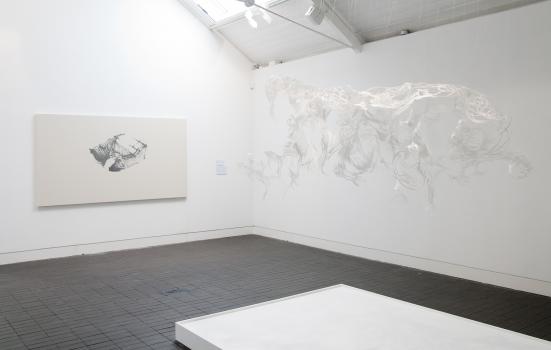Shonagh Manson shares her vision on how the relatively small Jerwood Charitable Foundation can directly support the early careers of contemporary craft makers.

Tomas Rydin
Independence is a state of being that is in our bones. Our founding organisation, the Jerwood Foundation, established the Jerwood Charitable Foundation as a UK registered charity in 1999. It then set us on our own path to independence in 2005 when it gifted an endowment of £25m to the charitable foundation, powering our mission to support talented artists and arts organisations. The income generated by this endowment allows us to commit £1.5m a year to people, projects and programmes across the UK and across artforms, with a focus on creating opportunities for those at the beginnings of their careers.
Albeit within the governance parameters of the Charity Commission, our independent funding enables us to set our own framework for risk around projects. We make our grant-funding available to individual artists directly as well as to organisations that are not registered charities. This is something that major trusts and foundations seldom allow. We do this precisely because it happens so rarely elsewhere; it is important we locate our limited resources in relation to the current landscape. The approach of getting to know our grant-holders and, for the most part, remaining closely in touch with the work they undertake allows us to mitigate risk, both before and at the point of decision-making, and during the life of a project. It is labour-intensive but rewarding, and broadens our understanding of what really challenges our beneficiaries, as well as helping us to fulfil this aim.
We gathered a range of thoughts on what we might be in a unique position to offer early career makers
Another goal is to advocate for best practice in grant-making, and we believe that the successes of supporting artists directly are something to shout about. Research shows that as funding for the arts is being squeezed in multiple directions it is the artist at the end of that food chain, from funder through organisation through project, who is being hit hardest. As a small foundation, our support is a drop in the ocean, but direct funding can have an amplified impact when applied alongside a portfolio of other opportunities. We must see more funding for individual practitioners made available.
Our style is informal as grant-making foundations go. You can call us up, tell us about your work and invite us to see it, or make a short initial application directly through our website. Generally though, we find the strongest and most relevant projects develop with conversation and time before taking a project forwards to our board of seven trustees. We want to understand the context of an issue or idea, and what else is or has happened in that area. To do that we often ask the advice of others, and this is true in our own self-directed work as much as through our open grants programme.
A significant self-led project is Jerwood Visual Arts, a year-round programme of exhibitions based at Jerwood Space in London, and on tour across the UK. Conversation (you might call it consultation) plays a strategic part in how we develop new projects within Jerwood Visual Arts. This was true in the genesis of the exhibition series called Jerwood Makers Open, the latest exhibition of which opened at Jerwood Space in July and will then be on display at the Pier Arts Centre in Stromness, Orkney from 14 September to 9 November.
Having run large-scale, prize-based projects for applied artists since the 1990s, in 2010 we reached an opportunity for review. Talking informally with curators, makers, critics and funders working with craft, we gathered a range of thoughts on what we might be in a unique position to offer early career makers. A key theme to emerge was that the nature of portfolio-working and funding structures in craft, unlike within other visual arts practices, meant that it was hard to gain significant funding for self-led, non-commercial new commissions. We heard a shared concern for maintaining gallery space in London for presenting non-commercial applied arts work, and those we spoke with also talked of the tricky relationship between contemporary craft and the visual arts. Jerwood Visual Arts, with its focus across varying areas of visual arts practice, was therefore seen to continue to offer an interesting context. So we put together the framework for a new opportunity that would support five makers each year with individual commissions for new work of £7,500 each. They are awarded on the basis of proposals independently led and submitted by the makers, without curatorial provocation or theme, yet with a touring exhibition opportunity and the development support of an exhibition team and budget.
The importance of keeping the space for independent, artist-led ideas remains the simple, central tenet of the series
This simple approach has allowed us to channel more than £100,000 directly to some of the most exciting emerging makers in the UK, realising work that has sparked further exhibition invitations, purchase requests from collections and new relationships.
The format is not without issue. Being led by a series of disparate ideas, materials, practice and process is challenging to translate as an exhibition for an audience, as the differing discussions of audience and staff on our touring partner Oriel Myrddin Gallery’s Jerwood Makers Open blog revealed in 2012. We also made subtle changes to what was on offer after reviewing the first year of the project, increasing from four commissions to five in subsequent years, expanding the conversations between them and introducing a longer making period. As always, the commitment and understanding of the selectors of each exhibition remains a make or break factor. But the platform of the show and the importance of keeping the space for independent, artist-led ideas remains the simple, central tenet of the series, and an important theme of many of our other successfully supported projects.
From the outstanding vision of Forest Fringe reclaiming territory for artists at the Edinburgh Fringe Festival, to the sparky, just-do-it attitude of young companies like Make Works and Buzzcut in Glasgow, all are examples of artist-led projects which prove that independence and collaboration are by no means mutually exclusive. We are delighted to have played a small role in their development, through which modest funds have been put to hard work, and amplified. And we would urge other funders to do the same, with an approach to considering artistic and governance risks which is accessible to application by those without substantial administrative engines behind them.
Shonagh Manson is Director of Jerwood Charitable Foundation.
www.jerwoodcharitablefoundation.org
www.jerwoodvisualarts.org
Entries for the Jerwood Makers Open 2014 open in September.




